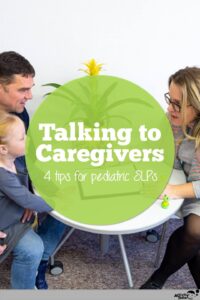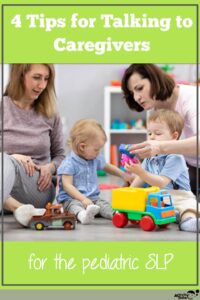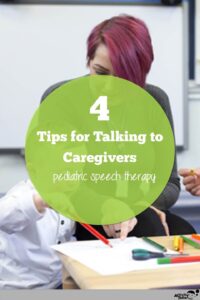Talking to caregivers is important and unavoidable as a pediatric SLP! Be prepared and handle these conversations with expertise and kindness.
As pediatric speech-language pathologists, we bring a lot of knowledge and expertise to the table and it’s easy to forget how foreign our speech world is to caregivers. Since speech therapists are often the first point of contact for many families with language delayed children, we need to remain mindful of ways we communicate with the caregivers we serve.
Our language can have an immediate impact on the level of trust a caregiver has in us. This trust can make a significant difference in their ability to learn and support their child’s speech and language goals.
Therapy outcomes are dependent on caregivers’ following through on recommendations for home, so focusing your attention on the therapist-caregiver relationship early on can have a huge impact!
4 Tips for Talking to Caregivers
Here are four tips you can use when talking to caregivers which strengthen the connection between therapy and home:
Consider the Caregiver’s Perspective
Listen to and value the caregiver’s perspective: Use this information to shape goals and activities. Try starting follow up questions or comments with these phrases to demonstrate your alignment with their viewpoint:
- I’m curious
- I wonder
- This is what I heard you say
Remember, taking time to listen to caregivers is the most important thing you can do, often even more important than caregiver training.
Think about the Big Picture
Consider the big picture. Choose goals that are meaningful to the family while taking into account obstacles that may get in the way. For instance, some families have expectations about children following rules or being seen/not heard. Often when you work with young families, there may be a pregnant caregiver or challenges with postpartum depression.
Be Realistic
Manage expectations. Give caregivers realistic progress and goal expectations which includes making sure you aren’t overestimating what a caregiver can learn/do within one session or season. As our own expertise increases, we start to lose perspective on how much info we have and in our excitement can being sharing too many recommendations at once. This can be intimidating overwhelming.
Our role is to be the guide for caregivers, not the hero!
Give Home Programs
Provide home programs to families. Give caregivers activities they can realistically do at home during their daily routines. Allow them opportunities for practice and to plan how/when they’ll follow through. You can also include:
- helping them teach other caregivers
- providing parent education on why and how to practice at home
Try these parent education handouts on a wide variety of topics:
- giving kids motivating homework so they take responsibility for remembering to practice
One player games are an engaging way to practice in therapy and again at home! Try these:
Work Smarter, Not Harder
Your clients won’t progress if the only speech and language practice they get all week is in a short session with you. By working with families, you maximize progress and decrease your own workload. It helps neither of you to push an agenda that can’t or won’t be followed.
If you are looking for more tips on talking to caregivers including a free one page parent handout to guide initial conversations, click here.








